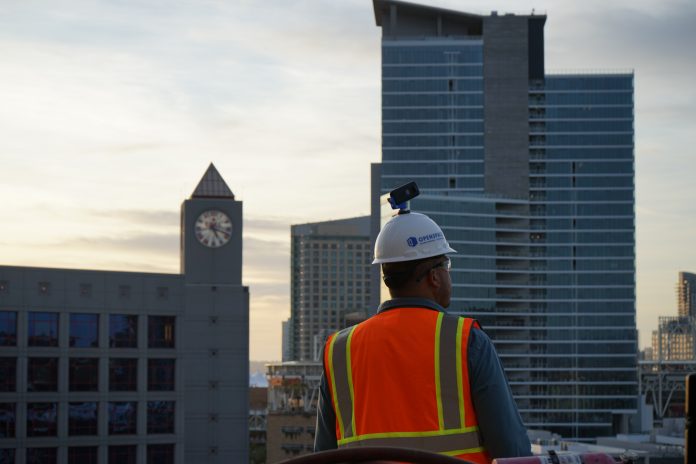Vinci Construction, a world leader in concessions, energy, and construction, is optimizing performance with OpenSpace
Goal: Speeding up site documentation, improving overall project management and optimizing performance with OpenSpace.
Vinci Construction UK used to document its building sites by manually snapping photos and physically marking a map where each was taken, said Marco Bonelli, Digital Leader at Vinci Construction UK. The photos and information were then uploaded to a server back at the office. “It would take a minimum of four hours weekly,” he said, “and that would be for the fastest users.” Not only was the process labor intensive, it ate into the valuable time of Project Managers and Engineers.
Since 60% of Vinci Construction’s business centers on healthcare infrastructure, robust documentation is a must-have, not a nice-to-have. As such, the company sought a documentation solution that could speedily capture sites at every stage of the build and easily match photos to project plans.
One of Bonelli’s primary responsibilities at Vinci is to discover, vet, and implement new technologies. “We were spending a lot of time doing documentation,” he said. “So I knew it was something we needed to address. We wanted to work smarter and spend less time on that aspect of the job.”
Deploying OpenSpace to fully document jobsites
After testing different software, Vinci decided to implement OpenSpace on a number of sites via Authorized partner, SEKTOR.build, the construction technology implementation specialists that help companies adopt new tools on-site. “In terms of quality, customer support, and ability to help us meet KPIs, OpenSpace was clearly the most suitable,” Bonelli recalled.
In December 2020, Vinci began using OpenSpace on its first project. After seeing its initial results, the company signed a new contract in January 2021 and deployed OpenSpace on three additional projects. By the first week of April, it was part of every project at Vinci.
“We brought it company-wide much faster than any technology before,” Bonelli said. He cited OpenSpace’s ease of use and SEKTOR.build’s facilitation as the reasons for the technology’s rapid expansion across Vinci.
“The key to our process is ‘digital driven by desire,’” Bonelli explained. “We saw how easy it was, and everyone loved that there was no uploading of the data required from the user. We are moving toward digital because we believe it is the right choice. But we make sure it is right not just at the company level, but also at the user level. And OpenSpace is.”
More than 6,000 hours saved annually using OpenSpace
OpenSpace is now a part of every construction project at Vinci, which currently totals 45 projects. Vinci is using OpenSpace not just for documentation, but also for BIM compare, progress tracking, and Field Notes functions to further improve efficiency on every build.
“OpenSpace is helping us manage all our projects better and get things done faster, but not just faster—it’s also helping us improve our quality,” Bonelli said.
To date, Vinci is seeing results in the following areas:
Time Savings: Vinci is reaping significant time savings in site documentation. In the past, this process would cost the company four hours weekly, for an estimated 6,000 hours annually. Documentation now happens in the background, giving Project Managers and Project Engineers the opportunity to direct their focus to more high-level concerns.
Cost Savings: OpenSpace helps Vinci quickly spot issues, avoid reworking, and resolve problems, thanks to the robust catalog of imagery provided by OpenSpace. For example, the speedy resolution of a dispute on one project using OpenSpace captures saved the company significant time and money.
Billing Accuracy: Office staff at Vinci use OpenSpace to enhance and expedite billing by touring sites virtually to verify that subcontractors have completed tasks and using that information to release payment. “It makes our process much more lean,” Bonelli said, “because we don’t need to send anyone to the site to complete the process.”
Verification: Vinci primarily uses Field Notes to verify that inspections on certain items have been completed and note where any issues were detected. Bonelli described one particular high-rise project, where every bathroom arrived at the site pre-built, ready to be lifted and affixed to a slab. With Field Notes, Vinci teams could quickly and easily inspect each bathroom and note any leaks or other repairs needed. “That was a super practical use of Field Notes that was a big help,” Bonneli said.
Improved Communication: From more robust reporting to shared folders that give clients a view of their project whenever they want it, the flow of information has improved at Vinci. That extends not just to stakeholders, but to the whole team. Company-wide, team members are learning from mistakes and improving quality by reviewing captures and using them to analyze how work has been performed, establish best practices, and share ideas for improvement.
Visit openspace.ai to learn more.
*Please note: This is a commercial profile

















